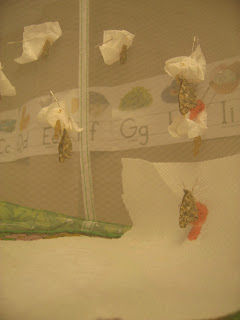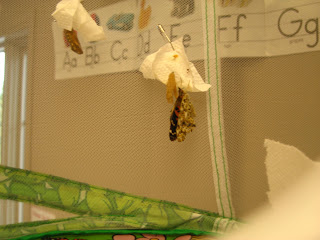After about 7-9 days, all of our butterflies had emerged from their chrysalis and were fluttering around the netting. Immediately upon entering our classroom, my 4 year old classes began saying, "Butterflies! The butterflies are out of their chrysalis!" We spent our group times sitting and standing around the netting to observe what these special creatures were doing. We used our senses - touch, sight, sound - to make observations and discover more about our butterflies. My co-workers and I did our best to document their comments, questions, and excitement through pictures and written documentation.
Here are some of our Painted Lady butterflies with brown under their wings and bright orange and black on the tops. We discovered that the red liquid was meconium or the unused "stuff" that a butterfly doesn't need after emerging from the chrysalis. The kids observed that the meconium looked like blood and we had an opportunity to discuss all the changes a caterpillar went through to become a butterfly. My co-worker, who has worked as a nurse, explained that newborns do a similar thing right after birth. I thought that this similarity between butterflies and humans was very interesting and spent some time reflecting on what I learned alongside of the children during this project. The Project Approach reminds me that I need to be a lifelong learner and that there is so much to discover through teaching preschool!
When we revealed the butterflies to the 3 year old class, they got very, very excited! They were laughing and starting to get a little wild so I asked them, "Do you think the butterflies would like it we sang to them?" We began singing some of our favourite songs to butterflies and this is what the children said:
"The butterflies like it when we sing"
"They are flying"
"Wow, the butterflies"
"There are so many"
"Look, teacher, look"
"These are so cool"
"They have wings. They are orange and black"
"One is crawling up"
The butterflies need to hang upside down after emerging from their chrysalis to stretch out their wings.
Once the butterflies started fluttering around the netting we knew that it was safe to hold them on our fingers.
The children would put their hand into the net and gently encourage the butterfly to crawl onto their finger.
Our 3/4 class really enjoys our music centre and will often spontaneously make a musical parade during free time. They wanted to share their music with the butterflies and I made the following observations:
"Maybe they will like our music"
"They are dancing"
"They are doing a dance"
"Where are their eyes?"
"He is finished eating here too"
"They are so big...wow!"
"They are dancing really fast"
"Sorry guy, I didn't mean to hurt you"
"Their wings dried off so they can fly"
"One is going to sleep like this. There is no pillows" (child rested head on hands)
"This one is sleeping in its food"
"It's flying"
"This one has its tongue out"
Our 4 year old classes read the Fancy Nancy book titled "Bonjour Butterfly" and their conversations surrounding the butterflies reflected their connections with this piece of literature.
"Bonjour, butterflies"
"Bananas (our puppet monkey friend) the butterflies are out"
"Look at their tongues"
"They are awesome"
"I can see their eyes"
"I love the butterflies"
"Look at them fly"
"They are a painted lady"
"They tickle!|"
"Their wings are the same"
"Their tongues are out"
"Bonjour!"
At group time we explored how a butterflies wings are symmetrical or the same on both sides. I drew one half of the butterfly and then asked what was missing. The children would say "the red circle" or the "blue square" and I would ask where to put it. Throughout the experience the children learned how to direct me specifically by saying "put it under the..." or "beside the..." and we explored spacial awareness at this time as well. Later during book and puzzle time the children used the whiteboard and markers to play this game with their friends. The experience not only offered fine motor opportunity, but also encouraged co-operation, working at a common goal, and group work.
I encourage you to try The Butterfly Project in your classroom. The butterflies are easy to take care of and we had 18 emerge out of the 19 we ordered. These creatures are a relevant and meaningful topic for the children because they can observe them as they go camping, to the park, or even walking down the street. The children were very engaged during this project and it was a great way to finish up our school year. Bonjour, butterflies!






No comments:
Post a Comment